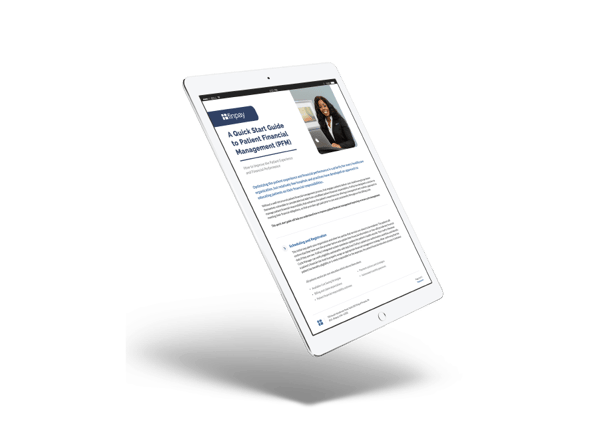Too often, patients refrain from seeking necessary behavioral healthcare because of negative...
In the New Year Deductibles Reset, How Will You Prepare to Operate at a Loss?
December 30, 2019
Written by: Lauren Anderson (COO)
It is almost 2020, which means a new cycle of patient delinquency for most health care organizations. As the calendar resets, so too do the health plans of most U.S. households, leaving them with an enormous financial responsibility—their annual health plan deductible. For many families, this deductible makes medical care financially unviable and forces them to delay or completely forego making payments to providers or seeking care at all.
As the average annual deductible goes up, more hospitals are resorting to extreme measures to recoup costs. Many healthcare providers are asking patients to provide credit card numbers upfront to cover out-of-pocket expenses, including deductibles that their insurer won’t cover. Unfortunately, this is compelling many sick patients to put off an important treatment that could head off worse health issues down the road. Furthermore, these tactics that increase financial uncertainty for the patient can easily sour the patient-provider relationship, which could mean lost future revenue.
How the Situation Got This Bad
The past decade has generally been a good economic period with steady economic growth, but this period has not seen a commensurate rise in worker wages. Despite record employment, wage growth has remained essentially flat. Prior to the recession in 2008, the annual growth rate for private-sector income was almost 4%. However, from 2013 to 2018, the annual wage growth rate has been between 2% to 3%.
Coupled with a rapidly growing financial responsibility for medical expenses, this wage stagnation has turned even modest financial surprises into major emergencies. During and following the most recent recession, more companies have transitioned their employees to High Deductible Health Plans (HDHPs) in an effort to save money.
Between 2007 and 2017, the number of Americans on HDHPs rose from 15% to almost 43%. In 2019, the average annual deductible is $1,655, more than double the average $826 in 2009. Consequently, the period in which patients are still paying off their annual deductibles has also grown. In 2006, this period lasted through February 28th, but in 2018, this period ended on May 14th.
This growing financial burden on patients has produced major changes in consumer payment behavior. McKinsey & Company estimates that healthcare providers can expect only 50% to 70% of patient balances. Additionally, 70% of providers said it took a month or longer to obtain payments from patients.
The Consequences of Patient Delinquency
These trends have had an enormous impact on healthcare providers who are increasingly reliant on patients for reimbursement. This coverage hole at the beginning of the year usually means that healthcare providers can see a significant drop-off in patient revenue.
This is especially dire for organizations that depend on patient revenue. The healthcare industry is growing more dependent upon patient collections. Definitive Healthcare reports that U.S. hospitals collected, on average, $282 million from patients in 2014, but this grew to $314 million in 2018.
However, it should be noted that net patient revenue growth is slowing year-over-year. From 2014 to 2015, the revenue grew $24 million, but this fell to only $4.7 million from 2017 to 2018. This is partially due to rampant growth in operating expenses. Between 2014 and 2018, the average hospital operating costs grew by almost $50 million.
The Solution is Patient Financial Management
If your company is like the rest of the healthcare industry, it is only collecting a tiny fraction of what it should from patients. On average, the industry collects only 19% of patient financial responsibility, leaving billions of dollars on the table. This poor collection rate is due to a host of factors, including patient confusion (30%), high deductibles (42%), poor provider communication (30%), and uncertainty about payment methods (11%).
There is a way to transform your patient revenue into a powerhouse—patient financial management (PFM). PFM leverages pre-care engagement to produce payment collection rates that top 80%. PFM leaders like FinPay are revolutionizing the industry by introducing collection strategies that are effective and preserve the patient-provider relationship.
PFM’s success is based on engaging the patient prior to the office visit. This engagement includes:
- Cost estimate: Using basic information regarding a patient’s insurer, health plan, and reason for the doctor visit, PFM specialists can produce a relatively accurate estimate of what the patient will owe. Patients will appreciate an early insight into how much their insurer is likely to contribute, as well as their ultimate financial responsibility.
- Payment options: It is essential that the patient is educated early on in the billing cycle about payment plans so that they can know about all available options and lock one in. This prevents confusion and non-participation once the final bill has arrived, and allows the patient to prepare for future payments.
- Financial resources: By offering financial resources like patient support programs, cash payment discounts, and medical loans, your organization can position itself as a patient advocate rather than an adversarial debt collector. Early advocacy will help cement the relationship so that future transactions can occur.
- Payment methods: More consumers prefer an online payment method that is easy and automated. Payment automation that directly bills a bank account or credit card is less likely to be missed, making your revenue stream more reliable and robust.
All of this pre-care engagement is predicated on a deep analysis of the patient, which produces a detailed risk profile. FinPay has pioneered patient financial management strategies that convert not only low-risk patients into fully paid accounts but also patients who present an over-sized risk of non-payment.
FinPay has designed a patient management handbook that enables providers to take full control of the relationship, ensuring that patient financial responsibility is fully paid and the patient experience is strengthened. These PFM techniques include workflow guides, consumer response strategies, and educational curricula that can enable billing personnel to manage almost any kind of patient.
Avoiding the New Year Revenue Dip
By implementing a top PFM program like those administered by FinPay, you can avoid the perennial revenue decrease due to resetting annual deductibles. Instead of losing out on months of revenue that is critical for sustainable enterprise operation, your organization can continue to serve patients without fear of financial disaster.
With your patient financial management program in place, you can rest assured that your patients will continue to make their payments. You can also be confident that new patients will fulfill their financial responsibility because they will lock in a payment structure long before they walk into your offices. Your billing department can avoid delinquent accounts and delayed payments because patients have already accepted their financial burden and are committed to paying it off.
Like your patients, you deserve some certainty about your financial future. With FinPay and our innovative patient financial management program, you don’t need to worry if your patients will pay you.
To learn more about patient financial management, please download the free ebook, “A QUICK START GUIDE TO PATIENT FINANCIAL MANAGEMENT (PFM).”






